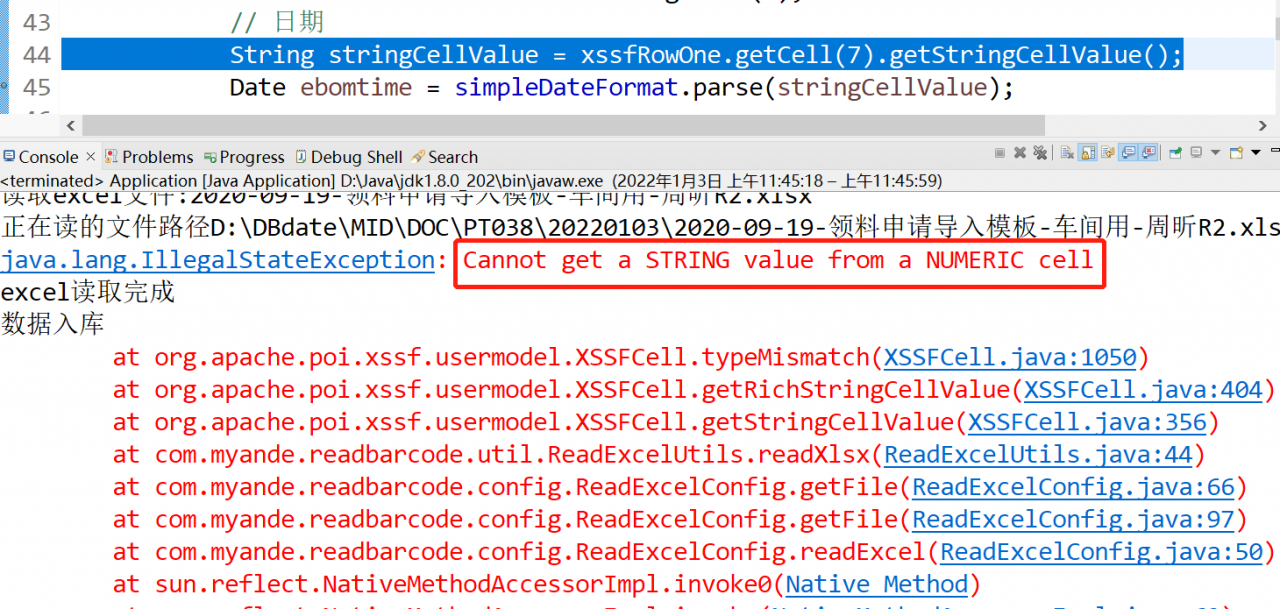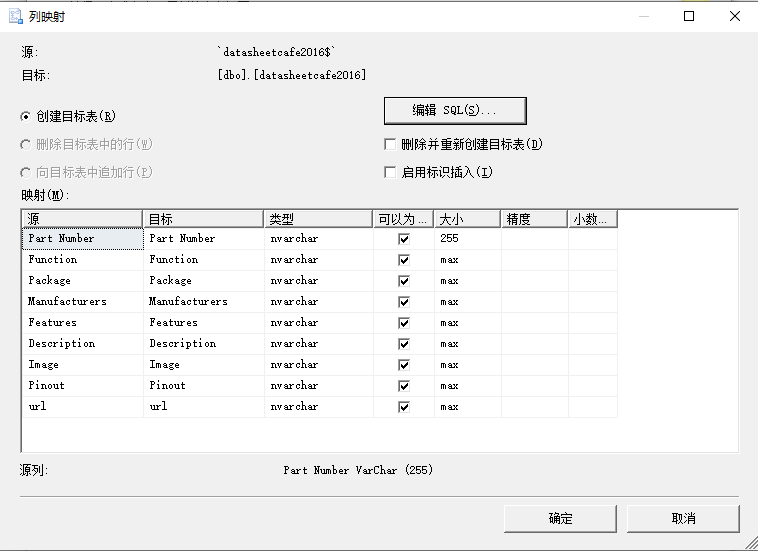1. Error information

2. Solutions
Declare the cell type as string before calling the getstringcellvalue() method
xssfRowOne.getCell(7).setCellType(CellType.STRING);1. Error information

2. Solutions
Declare the cell type as string before calling the getstringcellvalue() method
xssfRowOne.getCell(7).setCellType(CellType.STRING);Reason: the local file of file has been lost after the file is modified
Solution:
1. When uploading beforeupload, change the file to Base64 (bese64 has nothing to do with the local file status), and then change it to file. (this is troublesome. You can ask the background if you can change it and get the data through blob or arraybuffer)
Save Base64 format
const reader1 = new FileReader();
reader1.readAsDataURL(file);
reader1.onload = e => {
this.base64Excel = e.target.result;
};Base64 to file method:
base64ConvertFile (urlData, filename) { // 64 file
var arr = urlData.split(',');
var type = arr[0].match(/:(.*?);/)[1];
var fileExt = type.split('/')[1];
var bstr = atob(arr[1]);
var n = bstr.length;
var u8arr = new Uint8Array(n);
while (n--) {
u8arr[n] = bstr.charCodeAt(n);
}
return new File([ u8arr ], filename, {
type: type
});
},Finally, upload the transferred file through formdata
let excel = new FormData();
let form = this.base64ConvertFile(this.base64Excel, this.excelFile.name);
excel.append('file', form);2. When you click upload, you will be prompted to modify the file
this.file.slice( 0, 1 ) // only the first byte
.arrayBuffer() // try to read
.then( () => {
// The file hasn't changed, and you can send requests here
console.log( 'should be fine' );
axios({.........})
} )
.catch( (err) => {
// There is a problem with the file, terminate it here
console.log( 'failed to read' );
this.file = null; // Empty the cached file
} );catalogue
The text is truncated, or one or more characters do not match in the target code page
Cause
Solution
The value violates the integrity constraint of the column
Blank line
Not set to allow null
I have imported data before without reporting any errors. When importing data again today, I found two errors, as follows
It’s easy to understand that your data is too large and the size you set is not enough. There may be questions here
As shown in the figure below, if the size can be set, an error will still be reported after setting the size
This is because in order to determine the field type of the data table, the import and export of SQL server takes the first 8 lines of the excel file. If the first eight strings are less than 255, they are set to nvarchar (255). However, if the length of the records behind excel exceeds 255, an error will occur during import. Even if the length of this field is adjusted when importing the setting mapping

I added a row to the first row of Excel data, and each field is filled with long characters, so that SQL server will automatically set the maximum value when detecting the first 8 rows
This is because the new column behind you is a space. You can select the column behind the last field and delete it to eliminate the possibility of spaces. As long as there is no f beginning such as F10 when importing
There is another reason. This field is set to allow null. I cancelled it and the setting is not allowed to be Mull. Then an error is reported that a column violates data integrity
if it is reset to allow null, there is no problem
Beyond compare is an Excel to TXT script to solve the problems of special characters unable to output, multiple sheet pages unable to compare, and files too large to exceed the system memory
' XLS_to_CSV.vbs
'
' Converts an Excel workbook to a comma-separated text file. Requires Microsoft Excel.
' Usage:
' WScript XLS_to_CSV.vbs <input file> <output file>
Option Explicit
' MsoAutomationSecurity
Const msoAutomationSecurityForceDisable = 3
' OpenTextFile iomode
Const ForReading = 1
Const ForAppending = 8
Const TristateTrue = -1
' XlFileFormat
Const xlCSV = 6 ' Comma-separated values
Const xlUnicodeText = 42
' XlSheetVisibility
Const xlSheetVisible = -1
Dim App, AutoSec, Doc, FileSys, AppProtect
Set FileSys = CreateObject("Scripting.FileSystemObject")
If FileSys.FileExists(WScript.Arguments(1)) Then
FileSys.DeleteFile WScript.Arguments(1)
End If
Set App = CreateObject("Excel.Application")
'Set AppProtect = CreateObject("Excel.Application")
On Error Resume Next
App.DisplayAlerts = False
AutoSec = App.AutomationSecurity
App.AutomationSecurity = msoAutomationSecurityForceDisable
Err.Clear
Dim I, J, SheetName, TgtFile, TmpFile, TmpFilenames(), Content
Set Doc = App.Workbooks.Open(WScript.Arguments(0), False, True)
If Err = 0 Then
I = 0
For J = 1 To Doc.Sheets.Count
If Doc.Sheets(J).Visible = xlSheetVisible Then
I = I + 1
End If
Next
ReDim TmpFilenames(I - 1)
Set TgtFile = FileSys.OpenTextFile(WScript.Arguments(1), ForAppending, True, TristateTrue)
I = 0
For J = 1 To Doc.Sheets.Count
If Doc.Sheets(J).Visible = xlSheetVisible Then
SheetName = Doc.Sheets(J).Name
TgtFile.WriteLine """SHEET " & SheetName & """"
Doc.Sheets(J).Activate
TmpFilenames(I) = FileSys.GetSpecialFolder(2) & "\" & FileSys.GetTempName
Doc.SaveAs TmpFilenames(I), xlUnicodeText
Set TmpFile = FileSys.OpenTextFile(TmpFilenames(I), ForReading, False, TristateTrue)
'Write Writing the entire file will cause all the contents of the file to be lost if the write fails, so use the line-by-line method.
' It also prevents the problem of insufficient memory for too large files
while not TmpFile.AtEndOfStream
TgtFile.WriteLine TmpFile.ReadLine
Wend
'TgtFile.Write TmpFile.ReadAll
TmpFile.Close
If I <> UBound(TmpFilenames) Then
TgtFile.WriteLine
End If
Doc.Sheets(J).Name = SheetName
I = I + 1
End If
Next
TgtFile.Close
Doc.Close False
End If
App.AutomationSecurity = AutoSec
App.Quit
Set App = Nothing
For I = 0 To UBound(TmpFilenames)
If FileSys.FileExists(TmpFilenames(I)) Then
FileSys.DeleteFile TmpFilenames(I)
End If
Next
WScript.Sleep(1000)
'This step is to expose the failed window to the foreground for the user to close manually, which should be ignored by the On Error Resume Next catch above
App.Visible = true
If AppProtect.Workbooks.
' 'Protected processes can not just exit, the user may be using
' AppProtect.Quit
'End If
'AppProtect.Visible = true
'Set AppProtect = Nothing‘ XLS_to_CSV.vbs” Converts an Excel workbook to a comma-separated text file. Requires Microsoft Excel.’ Usage:’ WScript XLS_to_CSV.vbs <input file> <output file>
Option Explicit
‘ MsoAutomationSecurityConst msoAutomationSecurityForceDisable = 3′ OpenTextFile iomodeConst ForReading = 1Const ForAppending = 8Const TristateTrue = -1’ XlFileFormatConst xlCSV = 6 ‘ Comma-separated valuesConst xlUnicodeText = 42′ XlSheetVisibilityConst xlSheetVisible = -1
Dim App, AutoSec, Doc, FileSys, AppProtectSet FileSys = CreateObject(“Scripting.FileSystemObject”)If FileSys.FileExists(WScript.Arguments(1)) ThenFileSys.DeleteFile WScript.Arguments(1)End IfSet App = CreateObject(“Excel.Application”)’Set AppProtect = CreateObject(“Excel.Application”)
On Error Resume Next
App.DisplayAlerts = FalseAutoSec = App.AutomationSecurityApp.AutomationSecurity = msoAutomationSecurityForceDisableErr.Clear
Dim I, J, SheetName, TgtFile, TmpFile, TmpFilenames(), ContentSet Doc = App.Workbooks.Open(WScript.Arguments(0), False, True)If Err = 0 ThenI = 0For J = 1 To Doc.Sheets.CountIf Doc.Sheets(J).Visible = xlSheetVisible ThenI = I + 1End IfNextReDim TmpFilenames(I – 1)Set TgtFile = FileSys.OpenTextFile(WScript.Arguments(1), ForAppending, True, TristateTrue)I = 0For J = 1 To Doc.Sheets.CountIf Doc.Sheets(J).Visible = xlSheetVisible ThenSheetName = Doc.Sheets(J).NameTgtFile.WriteLine “””SHEET ” & SheetName & “”””Doc.Sheets(J).ActivateTmpFilenames(I) = FileSys.GetSpecialFolder(2) & “\” & FileSys.GetTempNameDoc.SaveAs TmpFilenames(I), xlUnicodeTextSet TmpFile = FileSys.OpenTextFile(TmpFilenames(I), ForReading, False, TristateTrue)’Write If you write the whole file, a write failure will cause all the contents of the whole file to be lost, so a line-by-line approach is used.’ It can also prevent the problem of too large file with insufficient memory while not TmpFile.AtEndOfStream TgtFile.WriteLine TmpFile.ReadLine Wend ‘TgtFile.Write TmpFile.ReadAllTmpFile.CloseIf I <> UBound(TmpFilenames) ThenTgtFile.WriteLineEnd IfDoc.Sheets(J).Name = SheetNameI = I + 1End IfNextTgtFile.CloseDoc.Close FalseEnd If
App.AutomationSecurity = AutoSecApp.QuitSet App = Nothing
For I = 0 To UBound(TmpFilenames)If FileSys.FileExists(TmpFilenames(I)) ThenFileSys.DeleteFile TmpFilenames(I)End IfNext
WScript.Sleep(1000)
‘This step is designed to expose the failed window to the foreground for the user to close manually, which should be ignored by the above On Error Resume Next capture App.Visible = true
If AppProtect.Workbooks.Count = 0 Then’ ‘The protection process can’t just exit, the user may be using ‘ AppProtect.Quit’End If’AppProtect.Visible = true’Set AppProtect = Nothing
Today’s development colleagues read the data from PostgreSQL and wrote it to excel. Due to the large amount of data, the development colleagues wrote the code that was not good enough and the speed was too slow, so there was a problem. I found the following information and modified the configuration of nginx to solve this problem. The detailed errors are as follows:
An error occurred.
Sorry, the page you are looking for is currently unavailable.
Please try again later.
If you are the system administrator of this resource then you should check theerror log for details.
Faithfully yours, nginx.Solution:
Change localhost in nginx configuration file to IP
Or
Modify the hosts file and add 127.0.0.1 localhost
location/{
proxy_pass http://localhost:8080 # change to 127.0.0.1
}Set connection time
proxy_ connect_ timeout 300; # The connection timeout between nginx and back-end server (proxy connection timeout)
proxy_ send_ timeout 300; # Back end server data return time (proxy sending timeout)
proxy_ read_ timeout 600; # After successful connection, the response time of back-end server (proxy receiving timeout)
is shorter
After modifying the configuration file, reload the configuration file
nginx -s reload
Error:
jxl.read.biff.BiffException: Unable to recognize OLE stream
at jxl.read.biff.CompoundFile.<init>(CompoundFile.java:116)
at jxl.read.biff.File.<init>(File.java:127)
at jxl.Workbook.getWorkbook(Workbook.java:268)
at jxl.Workbook.getWorkbook(Workbook.java:253)
at test1.main(test1.java:25)
Solution: No expenditure to read excel 2007 files (*.xlsx). Only excel 2003 (*.xls) is supported.
Udatatable is a component provided by UE4 to read and write files. The advantage is that you don’t need to write the logic related to C + + STL API, such as fopen and Fclose, to avoid the differences between different platforms; The disadvantage is that the DataTable function you want is not implemented, so you have to use fopen to play it yourself
Reading and writing excel needs to be exported as a CSV file. At present, *. XLS format is not supported
In the following official documents, there is no specific description about the usage of defining line structure with C + + Code:
If a DataTable is created from a blueprint, then the row structure structure can also use the structure component provided by UE4. The creation method is: add new blueprints structure, and then set the row structure in this structure
If you create a DataTable with C + + code, you can directly create a new C + + class and choose to inherit the DataTable. In addition, ftablerowbase can be directly defined in the header file of the custom datatable, for example:
#pragma once
#include "Engine/DataTable.h"
#include "CharactersDT.generated.h"
USTRUCT(BlueprintType)
struct FLevelUpData : public FTableRowBase
{
GENERATED_USTRUCT_BODY()
public:
FLevelUpData()
: XPtoLvl(0)
, AdditionalHP(0)
{}
/** The 'Name' column is the same as the XP Level */
/** XP to get to the given level from the previous level */
UPROPERTY(EditAnywhere, BlueprintReadWrite, Category = LevelUp)
int32 XPtoLvl;
/** Extra HitPoints gained at this level */
UPROPERTY(EditAnywhere, BlueprintReadWrite, Category = LevelUp)
int32 AdditionalHP;
/** Icon to use for Achivement */
UPROPERTY(EditAnywhere, BlueprintReadWrite, Category = LevelUp)
TAssetPtr<UTexture> AchievementIcon;
};Using excel to store gameplay data – DataTables
https://wiki.unrealengine.com/Using_excel_to_store_gameplay_data_-_DataTables
Data Driven Gameplay Elements
https://docs.unrealengine.com/latest/INT/Gameplay/DataDriven/index.html
Driving Gameplay with Data from Excel
https://forums.unrealengine.com/showthread.php?12572-Driving-Gameplay-with-Data-from-Excel
Methods for manipulating DataTable with blueprints.
Unreal Engine, Datatables for Blueprints (build & Use)
Excel to Unreal
https://www.youtube.com/watch?v=WLv67ddnzN0
How to load *.CSV dynamically with C++ code
If you have few tables you can use this self-contained DataTable, if you have many tables and will change them frequently, then you have to manually operate one by one in the UE editor after each change, so it is recommended to load *.csv dynamically in C++:.
FString csvFile = FPaths::GameContentDir() + "Downloads\\DownloadedFile.csv";
if (FPaths::FileExists(csvFile ))
{
FString FileContent;
//Read the csv file
FFileHelper::LoadFileToString(FileContent, *csvFile );
TArray<FString> problems = YourDataTable->CreateTableFromCSVString(FileContent);
if (problems.Num() > 0)
{
for (int32 ProbIdx = 0; ProbIdx < problems.Num(); ProbIdx++)
{
//Log the errors
}
}
else
{
//Updated Successfully
}
}